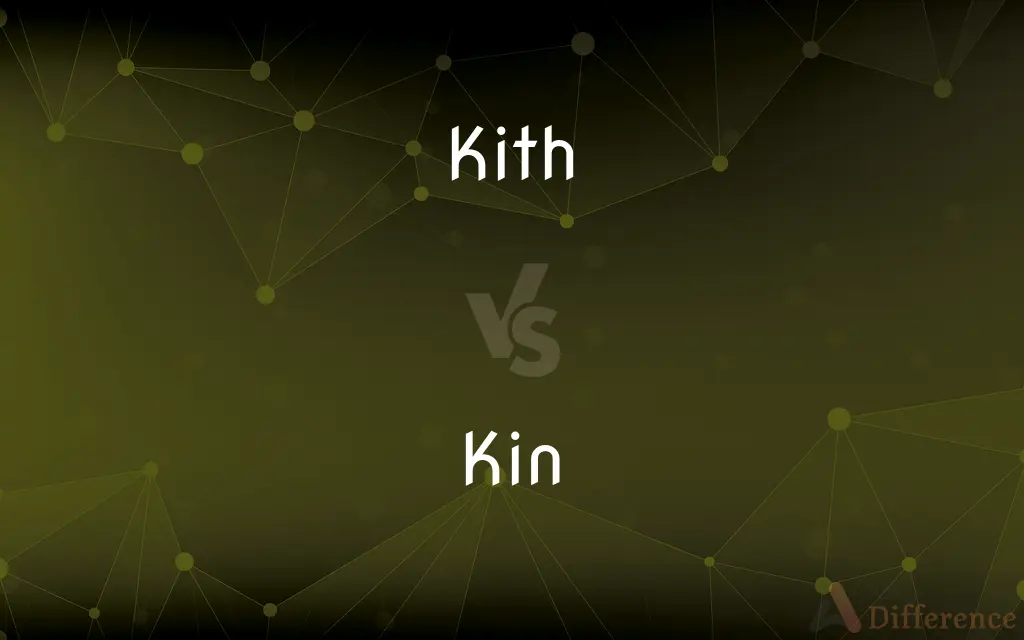Kith vs. Kin — What's the Difference?
Edited by Tayyaba Rehman — By Maham Liaqat — Updated on March 27, 2024
Kith refers to one's friends, acquaintances, and neighbors, emphasizing social connections, while kin denotes family members and relatives, highlighting blood or legal ties.

Difference Between Kith and Kin
Table of Contents
ADVERTISEMENT
Key Differences
Kith encompasses the broader social network of an individual, including friends, colleagues, and neighbors—people with whom one shares companionship and support, but not necessarily familial bonds. On the other hand, kin refers specifically to individuals connected by blood relations, marriage, or adoption, including parents, siblings, cousins, and spouses. This distinction highlights the difference between social and familial connections.
The concept of kith dates back to times when community ties were crucial for survival and well-being, reflecting the importance of social bonds and mutual assistance among non-relatives. Whereas, kinship has always been a fundamental aspect of human society, defining familial structures, inheritance, and social status based on lineage and marital connections.
In many cultures, the responsibilities towards kin are defined by societal norms and legal obligations, such as providing support and care, which are not typically mandated for kith. However, the significance of kith should not be underestimated, as these relationships greatly enrich one’s social life and can sometimes become as close as those with kin.
The distinction between kith and kin also plays a crucial role in legal and social contexts, where rights, duties, and privileges may be determined based on whether a relationship is by blood or social. For example, kin are often given priority in legal matters such as inheritance, guardianship, and decision-making in health emergencies.
While kinship bonds are primarily immutable, determined by birth or legal processes like marriage and adoption, kith relationships are formed and maintained through social interaction, shared experiences, and personal choice, reflecting the dynamic nature of human social connections.
ADVERTISEMENT
Comparison Chart
Definition
Friends, acquaintances, and neighbors.
Family members and relatives by legal ties.
Basis of Relation
Social connections and shared experiences.
Blood relations, marriage, or adoption.
Social Role
Provide companionship, support, and social enrichment.
Define familial structure, inheritance, and obligations.
Legal Recognition
Limited legal obligations or rights.
Specific legal rights and obligations in many contexts.
Nature
Formed and maintained by choice.
Immutable, determined by birth or legal processes.
Compare with Definitions
Kith
Friends and social circle.
She invited her kith to celebrate her new job.
Kin
Immediate family members.
His kin, including parents and siblings, supported him through his recovery.
Kith
Acquaintances from clubs or groups.
His chess club introduced him to a wider kith.
Kin
Extended relatives like cousins, aunts, and uncles.
The family reunion was attended by kin from across the country.
Kith
Members of a social or religious community.
The festival was a time for kith to come together in celebration.
Kin
Ancestors and descendants.
The genealogy project traced his kin back several generations.
Kith
Colleagues and neighbors.
The community picnic was a gathering of local kith.
Kin
In-laws and step-relatives.
Her marriage introduced her to a new set of kin.
Kith
School or college friends.
College reunions reunite one with their long-lost kith.
Kin
Adoptive family members.
Adoption created new kinship bonds that were as strong as blood.
Kith
Friends and acquaintances.
Kin
(used with a pl. verb) One's relatives or family
Visited my aunt and her kin.
Kith
An acquaintance or a friend.
Kin
A relative or family member
Is she kin of yours?.
Kith
Acquaintance; kindred.
And my near kith for that will sore me shend.
The sage of his kith and the hamlet.
Kin
(used with a pl. verb) Organisms that are genetically related to another or others
Cauliflower and its kin.
Kith
Your friends and acquaintances;
All his kith and kin
Kin
Related genetically or in the same family.
Kin
Related or similar; akin
"If he feels a wisp of longing for her ... it is kin to what the serpent must have felt for Eve" (Barbara Klein Moss).
Kin
Race; family; breed; kind.
Kin
(collectively) Persons of the same race or family; kindred.
Kin
One or more relatives, such as siblings or cousins, taken collectively.
Kin
(fandom) A fictional character who one deeply relates to.
Kin
Someone who relates deeply to a certain fictional character.
Kin
To identify with; as in empathize or emotionally relate to a fictional character.
Kin
A primitive Chinese instrument of the cittern kind, with from five to twenty-five silken strings.
Kin
Relationship, consanguinity, or affinity; connection by birth or marriage; kindred; near connection or alliance, as of those having common descent.
Kin
Relatives; persons of the same family or race.
The father, mother, and the kin beside.
You are of kin, and so a friend to their persons.
Kin
The unit velocity in the C. G. S. system - a velocity of one centimeter per second.
Kin
Of the same nature or kind; kinder.
Kin
A person having kinship with another or others;
He's kin
He's family
Common Curiosities
Can kith become kin?
Through legal processes like marriage or adoption, a person who is originally part of one's kith can become kin.
Is the concept of kith as important as kin?
While different in nature, the concept of kith is equally important for an individual's social well-being and sense of community.
Why are kinship ties important?
Kinship ties are crucial for defining family structures, responsibilities, inheritance, and providing mutual support.
What's the key difference between kith and kin?
The key difference lies in the nature of the relationship: kith are social connections, while kin are family connections.
How do cultural practices affect perceptions of kith and kin?
Cultural practices greatly influence the importance, roles, and expectations of both kith and kin, varying significantly across societies.
How does one's social circle influence their life compared to family?
Social circles provide companionship, diverse perspectives, and support beyond what one may receive from family, enriching one’s social life.
Do legal systems recognize kith relationships?
Legal recognition of kith relationships is limited and varies, unlike the more defined legal status of kin.
Can the definition of kin extend beyond blood relations?
Yes, kin can include those related by marriage, adoption, or other legal family bonds.
What role does kinship play in inheritance laws?
Kinship often determines legal rights to inheritance, with laws varying by jurisdiction but generally favoring blood relatives and spouses.
How are kith relationships formed?
Kith relationships are formed through social interactions, shared interests, and personal choices, reflecting the dynamic nature of human connections.
Share Your Discovery

Previous Comparison
Shining vs. Shiny
Next Comparison
Blue vs. AzureAuthor Spotlight
Written by
Maham LiaqatEdited by
Tayyaba RehmanTayyaba Rehman is a distinguished writer, currently serving as a primary contributor to askdifference.com. As a researcher in semantics and etymology, Tayyaba's passion for the complexity of languages and their distinctions has found a perfect home on the platform. Tayyaba delves into the intricacies of language, distinguishing between commonly confused words and phrases, thereby providing clarity for readers worldwide.













































